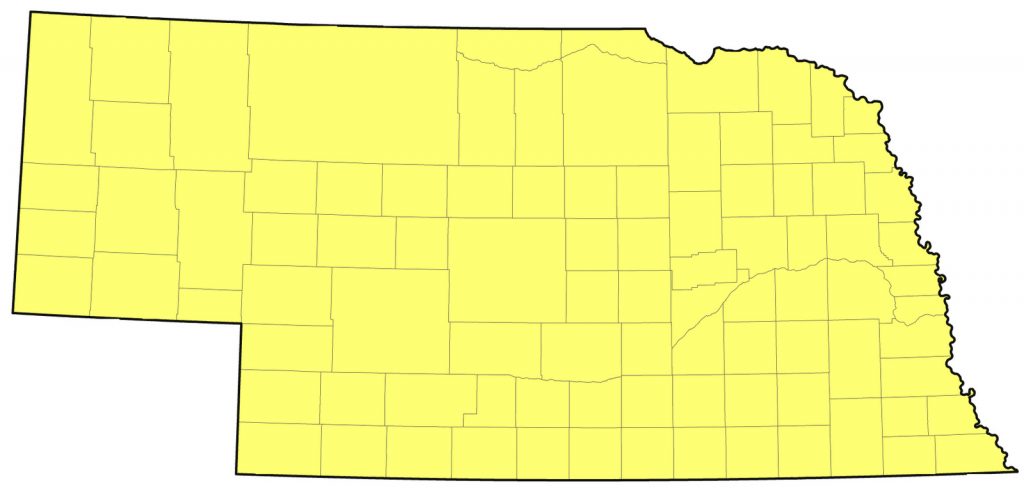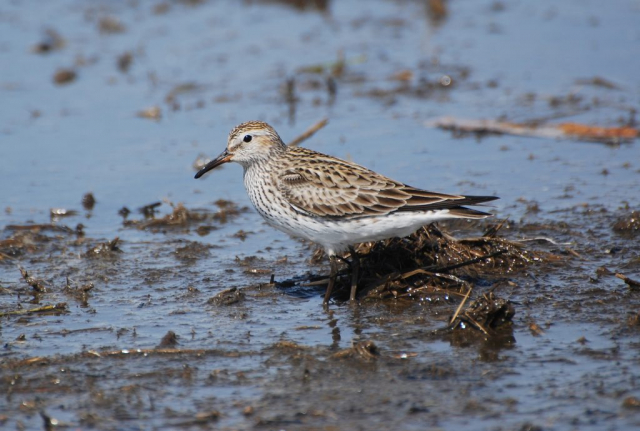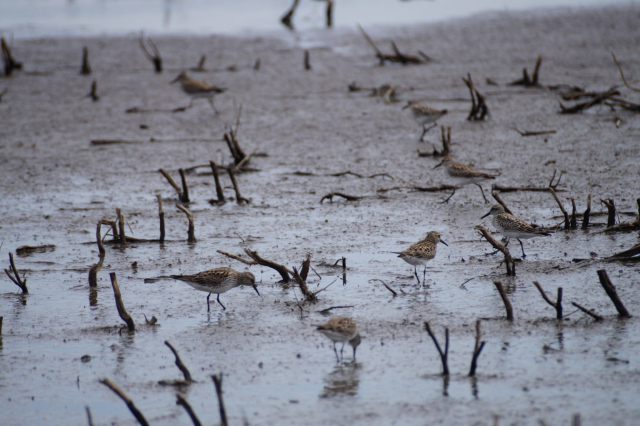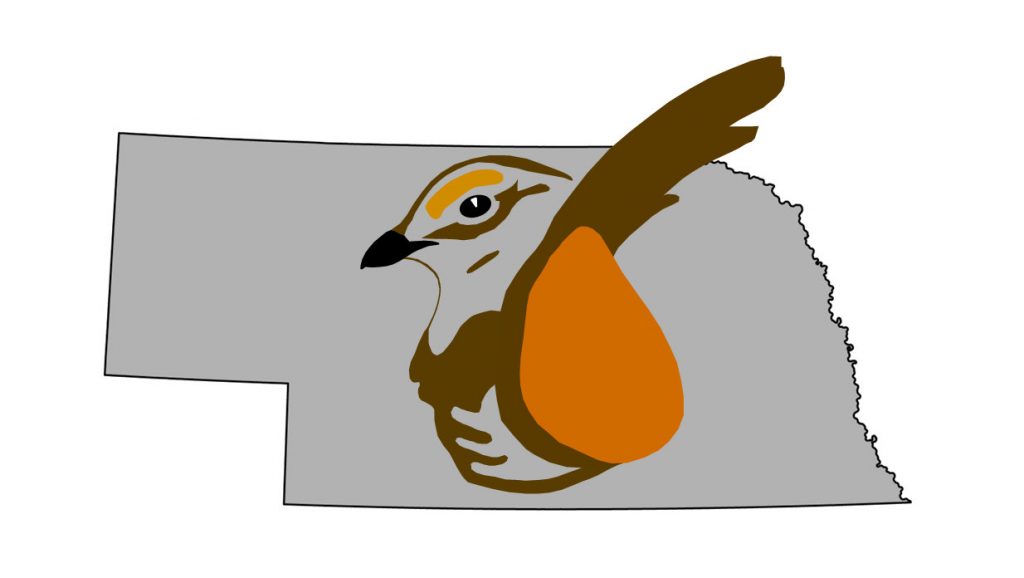Calidris fuscicollis
Status: Common regular spring migrant statewide. Rare casual fall migrant central and east.
Documentation: Specimen: UNSM ZM6159, 17 Jun 1902 Cherry Co.
Taxonomy: No subspecies are recognized.
Spring: Apr 19, 19, 19 <<<>>>Jun 24, 25, 26
Early dates above are documented.
Later dates are of four at Hultine WPA, Clay Co 28 Jun 2008, and one on the Platte River near Louisville, Cass Co 3 Jul 2008. There are specimens 17 Jun 1902, cited above, and 21 Jun 1902 Keya Paha Co UNSM ZM6160.
As discussed under “Fall”, below, evidence suggests that Jul and early Aug reports may be of individuals that have delayed spring migration. There are these such records for Nebraska: 20 Jul 2001 Harvard WPA, Clay Co adult “seen well and heard” (Stephen J. Dinsmore, personal communication; Jorgensen 2004, 2012), 21 Jul 2009 Frontier Co, 25 Jul 2009 injured wing Harvard WPA, Clay Co, 31 Jul 2002 Perkins Co, 31 Jul 2007 Keith Co, and 7 Aug 2014 Lancaster Co.
The first birds generally arrive by the very end of Apr or early in May, but numbers do not peak until mid-May. Unlike other species, the regular migration period of White-rumped Sandpiper extends well into Jun and probably stragglers occur later. During late May, flocks of Calidris sandpipers are usually dominated by this species and Semipalmated Sandpipers.
There are at least 20 undocumented early dates in the period 28 Mar-18 Apr which we have discounted.
- High counts: 7000 in the eastern Rainwater Basin 18-20 May 2005, 5544 there 16-18 May 1997 (including 3600 at Freeman Lakes WPA, York Co 17 May), and 4000 there 17 May 2007.
Fall: Although there are about 45 fall (Jul-Sep) reports for Nebraska, existing data for states neighboring Nebraska (see Comments) suggests reports through early Aug may represent tardy spring migrants not completing migration; these reports are discussed under “Spring”.
We consider these four reports to represent vagrant fall migrants:
24 Aug 1983 Dawson Co (eBird.org)
5 Sep 2004 Holmes Lake, Lincoln, Lancaster Co (eBird.org)
9 Sep 2001 five juveniles at Lake North, Platte Co (eBird.org)
30 Sep 2018 Polk Co (Jorgensen photo, eBird.org).
Comments: The potential occurrence of White-rumped Sandpiper in Nebraska is analogous to that of Hudsonian Godwit, which follows a similar elliptical migration route (O’Brien 2006, Parmelee 2020), with numerous spring records and very few in fall; there are only nine accepted fall records of Hudsonian Godwit for Nebraska. The temporal and spatial occurrence of White-rumped Sandpiper in Nebraska and the Great Plains is in need of clarification. Examination of records of White-rumped Sandpiper in Nebraska and neighboring states Jul and later show numerous reports through 5 Aug, probably tardy spring migrants not completing migration (see Spring). There are however a surprising number of reports 7 Aug-4 Nov, the 50 such reports mostly from central Kansas during the 1970s but including reports for all states neighboring Nebraska (eBird.org, accessed Oct 2023). Thompson et al (2011) list high fall counts of 100, 42 and 25 for Kansas, but without citation. The only fall specimens taken in any of the neighboring states are from Kansas where Thompson et al (2011) mention an unknown number of specimen records from “9 July (Stafford Co.) to 29 September (Barton Co.)”. The latter date presumably refers to an individual collected at Cheyenne Bottoms, Kansas, 29 Sep 1957 (Emporia State University #B590).
Images
Abbreviations
UNSM: University of Nebraska State Museum
WPA: Waterfowl Production Area (Federal)
Literature Cited
Jorgensen, J.G. 2004. An overview of shorebird migration in the eastern Rainwater Basin, Nebraska. Nebraska Ornithologists’ Union Occasional Paper No. 8. Nebraska Ornithologists’ Union, Lincoln, Nebraska, USA.
Jorgensen, J.G. 2012. Birds of the Rainwater Basin, Nebraska. Nebraska Game and Parks Commission, Lincoln, Nebraska, USA.
O’Brien, M., R. Crossley, and K. Karlson. 2006. The Shorebird Guide. Houghton Mifflin Co., New York, New York, USA.
Parmelee, D.F. 2020. White-rumped Sandpiper (Calidris fuscicollis), version 1.0. In Birds of the World (A.F. Poole, P.R. Stettenheim, and F.B. Gill, Editors). Cornell Lab of Ornithology, Ithaca, NY, USA. https://doi.org/10.2173/bow.whrsan.01.
Thompson, M.C., C.A. Ely, B. Gress, C. Otte, S.T. Patti, D. Seibel, and E.A. Young. 2011. Birds of Kansas. University Press of Kansas, Lawrence, Kansas, USA.
Recommended Citation
Silcock, W.R., and J.G. Jorgensen. 2023. White-rumped Sandpiper (Calidris fuscicollis). In Birds of Nebraska — Online. www.BirdsofNebraska.org
Birds of Nebraska – Online
Updated 11 Oct 2023


